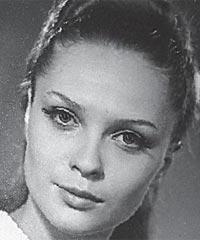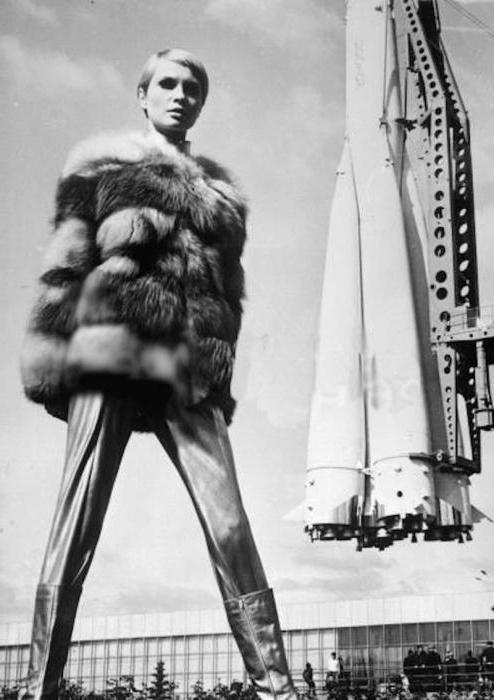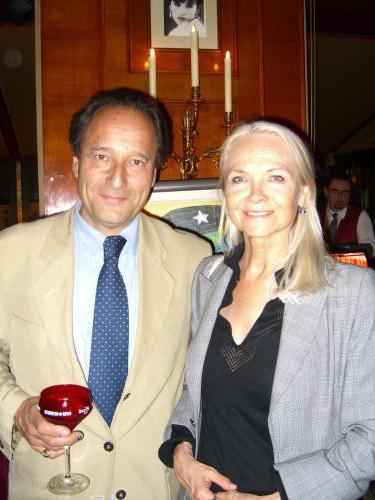The profession “model” did not exist in Soviet times, so the girls who walked the catwalk were called “clothing demonstrators” or “fashion models”. But in reality in the Soviet Union, models were of the highest level. The Soviet fashion model Galina Milovskaya was just from this caste, but her life in the homeland did not work out. But she successfully realized herself in the West.
The beginning of the way
Galina Milovskaya was born in the capital of the USSR - Moscow, in a poor family. She and her sisters were raised by one mother, her father died when Gale was 13 years old. The girl dreamed of becoming an actress, especially since her external data were quite worthy: a tall, thin blonde, with delicate facial features and huge eyes, she embodied the modern ideal of female beauty. Galina successfully passed the exams and entered the theater school. B. Schukin. It was interesting to study, only that there was always not enough money, the scholarship was only 30 rubles. A friend at the school told Galina that at the All-Union Institute for the Assortment of Light Industry, she could work as a clothing demonstrator. Milovskaya came there and was greeted with a bang. With a height of 170 cm and a weight of 42 kg, she ideally suited modern model standards, and her appearance made her look like the trendy Western fashion model Twiggy. Galina was hired by the Fashion Prospect department, and she began to learn a new profession. Then there were no courses for fashion models, and the girls themselves learned to walk on the catwalk, developed a model walk. Galya quickly learned tricks and became a sought-after fashion model.

Historical context
In those days when Galina Milovskaya decided to become a fashion model, in the USSR this profession, to put it mildly, was not at all prestigious. During the Brezhnev stagnation, the public paid great attention to the morality of Soviet citizens. Exposing the body (open knees, décolleté, even quite innocent) was considered an insult to public taste. A woman had to embody the features of a worker, an exemplary mother and a respectable wife, there was no talk of any femininity, and even less so of sexuality. The hypocritical Soviet morality believed that female attractiveness and its demonstration degraded the dignity of Soviet citizens. The society also vigilantly followed the patriotic moods of the population. Any disrespectful attitude to the symbols of Soviet power was severely punished. You could go to jail for a political joke, and lose your job for improper treatment of portraits of leaders. Against the background of this implanted patriotism, all admiration for Western culture and lifestyle was perceived as an insult to the Soviet system. The West was an enemy, and it was only possible to scold him, it was impossible to praise him and encourage the planting of Western values in Soviet society. They didn’t go to jail for communication with foreigners as they did under Stalin, but they took a person to the note and kept a close eye on his behavior. The suffocating atmosphere led to the fact that many freedom-loving citizens and simply people of wide views, under any pretext, left the country. Emigration was perceived by many representatives of the creative intelligentsia as liberation.

Career model
Against this historical background, Galina Milovskaya (fashion model) chooses a lifestyle that is not quite right from the point of view of power and morality. In the new profession, she quite took place. She worked a lot, demonstrating clothes of the Moscow House of Models. Gradually, she became known in her circles, she was called "Russian Twiggy." In 1967, she was among the few carefully selected demonstrators participating in the USSR's only International Fashion Festival. This event gathered a lot of foreign journalists and photographers, they came including in search of new faces. One of the finds was Galya Milovskaya, her image was remembered by the leading photographer of the Vog magazine.
The history of the famous photo
Two years after the Fashion Festival, photographer Andre de Ronet arrives in Moscow to conduct a photo shoot for the Vog magazine, and with his model he saw only Milovskaya. The magazine did a lot of preparatory work and received unprecedented permissions on the set in the Kremlin Armory and on Red Square. Galina Milovskaya said that filming in the treasury took place under the supervision of 17 machine gunners. She was given the rod of Catherine the Great and the greatest diamond Shah. For this shoot, "Vogue" allocated 8 pages of the magazine. At the same time, Milovskaya did not receive a penny for her work, the entire fee was sent to the state treasury. The most famous was the photograph in which Galina sits, spreading her legs, against the backdrop of the Kremlin and the mausoleum.
Conflict with the authorities
This shot infuriated officials. Galina was called "on the carpet" by the Minister of Light Industry, who literally yelled at her in obscene terms, accusing her of insulting the most holy - Lenin. “You would have walked naked on Red Square,” he shouted. So, Galina Milovskaya, whose biography was 100% dependent on officials, lost her part-time job in foreign magazines. Despite her boss’s attempts to blame everything on her “lack of thought”, she was forbidden to film abroad. But the trouble did not end there. Its leaders from the school in some strange way got to the show of swimsuits, in which Galya took part. They said that she fell so morally that she could not claim the title of Soviet actress - she was expelled from the school.
The story of body art
The last nail in the coffin of his career was a scandalous event for the USSR with experiments in body art. Galina Milovskaya, fashion model, became a model for the artist Anatoly Brusilovsky. He organized an event for his acquaintance, a photographer from Cayo, Mario Garrubba from the Italian magazine Espresso, a vivid photo shoot. At home, he made several friends, invited Galya as a model, and made beautiful paintings on her naked body in the form of flowers, butterflies, and birds. The photographer took the whole process and printed it in his magazine. The scandalous nature of the action with a naked body was reinforced by the fact that under the photo of the artist was printed the poem "Terkin in the Other World" by V. Twardowski, banned in the USSR. All this infuriated Soviet power and Milovskaya blocked all oxygen. She was categorically not allowed to work, despite the fact that she received very advantageous offers from the West. So, the owner of a very large modeling agency Eileen Ford did a lot to sign a contract with Milovskaya, she even managed to get a letter from President Nixon sent to the USSR. But the Soviet government did not give Galina the opportunity to work.

Emigration
Model Galina Milovskaya was forced to start thinking about leaving the country. Her emigration was not political, she repeatedly emphasized that there was never any anti-Sovietism in her actions, that she simply participated in interesting art events and in no way fought with the system. A. Brusilovsky helped organize the departure, he was able to make her a call to Israel. April 14, 1974 she flies to Rome, where Eileen Ford was waiting for her. She arranged for Galina to participate in the competition for the highest paid models in the world. Galina was chased by photographers, they were surprised that she never smiled. She was very worried about leaving, thinking about the fate of her relatives.
Career in the West
Galina Milovskaya was able to integrate into the Western modeling business. She settled in London, starred in many European magazines, often visited Paris. She did not become a top model, but she could earn a decent life. At this time, she met a lot of people, studied a new lifestyle, but always remained a Russian girl. Regardless of her desire, her career still acquired a political connotation, she was even called "Solzhenitsyn in a skirt."
Marriage
At one of the meetings in Paris, Galina met with the banker Jean-Paul Dessertin. After 15 minutes, he made her an offer, and she accepted it. The next day, the couple signed at the city hall and for more than 30 years they have been together. Galina Milovskaya, whose birth date (1949) is a secret carefully guarded by her, considers her new birthday a moment of departure from the USSR, when she was able to change her whole life in an instant. The couple had a daughter, who today is one of the leading ethnologists in Guinea.
New life
Having married, Galina refused a career as a model, she finally decided to get an education. She entered the Sorbonne at the faculty of filmmaking. She took part in this profession, having shot several documentaries, including “The moment when memories come” about the residents of a nursing home and “These crazy Russians” about Russian avant-garde artists who were forced to leave their homeland in the 70s of the 20th century. And today she is filming reports and short stories about Russian art in the West.
Even during the years of Soviet power, thanks to her husband’s ties, Milovskaya managed to visit her homeland three times as part of official delegations. After perestroika, she can regularly meet with relatives and visit Russia. She even presented her film at the Leningrad Festival. Galina Milovskaya is now a successful, self-sufficient woman with a happy fate.